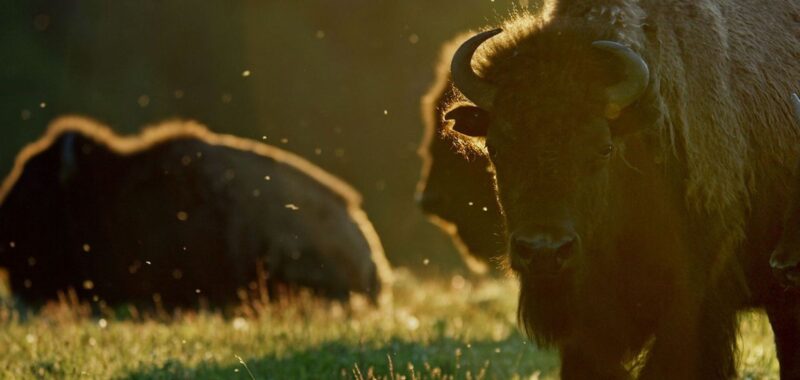PHILADELPHIA — At the BlackStar Film Festival in Philadelphia last weekend, a new feature documentary directed by Blackfeet (Niitsitapi/Siksikaitsitapi) siblings Ivan and Ivy MacDonald alongside filmmaker Daniel Glick won the Center for Cultural Power’s Climate Justice Award for the Best Director of Climate Storytelling. The 86-minute film, Bring Them Home (2024), chronicles the Blackfeet Nation’s uphill battle to rekindle the traditional practice of stewarding wild buffalo after generations of separation due to forced assimilation and oppressive legislature.
“At a time when our planet is on fire, it is critical that we recognize that the climate crisis started with colonialism and that Indigenous storytellers help us confront, acknowledge, and mourn what was lost, as well as to decolonize our imagination around climate solutions,” said Favianna Rodriguez, president of the Oakland-based Center for Cultural Power, in a statement shared with Hyperallergic.
Shot between the Blackfeet Indian Reservation in northwest Montana and the Blood Tribe (Kainai Nation) land in southern Alberta, Canada, astonishing aerial views of the Great Plains and Glacier National Park set the scene as Nez Perce (Nimíipuu) and Piegan Blackfeet (Siksikaitsitapi) actor Lily Gladstone narrates the production. Starting with the spiritual and ecological significance of wild buffalo populations in the area, Gladstone’s words are supplemented by insights from various Blackfeet tribal elders who underscore that no part of the enormous animal goes to waste when it comes to both subsistence and cultural customs.

Though the powerful and symbiotic relationship between the buffalo and the Blackfeet people dates back thousands of years, by the late 19th century the species was driven to near extinction at the hands of European American settlers encroaching westward. In addition to the extractive commercialization of buffalo hides, the United States military was ordered to slaughter as many animals as possible as a means of controlling and defeating the Native American populations through resource scarcity.
This fractured relationship was exacerbated by displacement and forced assimilation of the Blackfeet people into Christo-American society, including through abusive residential schools and punitive laws surrounding Indigenous culture and language use. Bring Them Home also highlights the Dawes Act of 1887, which divided communal Native land into individual plots allotted to the “heads” of families to force Indigenous people into ranching and farming within the US capitalist framework, as another contributor to the Blackfeet people’s separation from their traditions.
Ivy MacDonald told Hyperallergic that while she and her brother, co-director Ivan, grew up learning the customs and traditions surrounding buffalo, neither of them had a lot of in-person exposure to the animals growing up. MacDonald specified that throughout filming, she was fascinated with the social structures of buffalo herds, observing their body language and witnessing that “they grieve for each other” when a member of the herd is slaughtered.
“Even in the film, there’s a point where a group of mother buffalo are grazing while one or two of them hang back to watch over the calves,” MacDonald continued. “It’s like how we are as Indigenous people … It’s not weird that adults still live all together because that’s how we lived back in the day, we had a community. Everyone took care of everyone, and that’s what we’ve learned from buffalo.”
Over a century after the buffalo’s near extinction and the compounded suffering faced by the Blackfeet Nation, tribal elders posited that rediscovering the relationship with buffalo was critical for healing from divisive colonial impositions and their resounding impacts felt today. Reintroducing the species would also restore an ecological balance that had been thrown off after it was almost completely extinguished, considering that herds lived in equilibrium with the land for millennia.

The documentary revisits the Montana reservation’s first attempt to rekindle buffalo stewardship in the late 1970s, when the tribal council secured a herd from Yellowstone National Park that was turned loose on the land. The Dawes Act yielded generations of Blackfeet cattle ranchers and farmers who were firmly against the wild buffalo presence as they were destructive and interfered with the crops, resulting in irreconcilable hostilities that caused the tribal council to sell off most of the herd. A similar effort unfolded on the Blood Tribe land in 1993 in Alberta, though it only lasted a single day as the tribal head purchased buffalo without total council approval, sowing internal conflict.
The MacDonalds and Glick also shed light on the Blackfeet Nation’s second and third attempts to restore a wild buffalo population on the land, and how reviving interest in their presence and significance caused a cultural shift in the community that better prepared members for reintegrating the species over the following decades. Eight years in the making, the documentary incorporates archival footage and imagery as well as the voices of Blackfeet cowboys Truman “Mouse” Hall and Ervin Carlson, Blackfeet scholar and knowledge-keeper Leroy Little Bear, and Blood Tribe environmentalist and buffalo advocate Paulette Fox.
Regarding the attitude change toward wild buffalo on the land, MacDonald told Hyperallergic that “seeing is believing.”
“Seeing all of this cultural knowledge being restored and people wanting to learn more about it is beautiful,” she said. “It’s such a cool thing to regain that power that we’ve never lost but we’ve been a little disconnected from, throughout our genocide and our colonization.”


